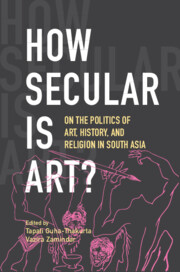2 - Indian Secularism and Art in a Time of Crisis
Published online by Cambridge University Press: 21 February 2023
Summary
A Distinction and a Definition
I will begin very briefly with a ground-clearing distinction and an attempt at definition before taking up the larger theme of this volume—the bearing of the crisis of Indian secularism in recent decades on modern Indian art. The distinction is elementary and should be familiar, but it bears repeating—between ‘secularism’ and ‘secularization’.
Secularization, a topic first fully explored by Max Weber, unlike secularism, is not a doctrine so much as a name for a process of transformation in society. It has, in the sociological and historical literature, been described by two quite different rhetorics: ‘the death of God’ and the ‘decline of magic’ and ritual, thus addressing religion as both belief and cultural practice. Loss of belief in God or in the myths of creation, on the one hand, and the decrease in church-going (liturgical rituals) or habits of pious dress and dietary restrictions, on the other, were two distinct symptoms of the process of secularization in the European modern, speaking respectively to secularization of religious doctrine and practice.
The concept of secularism, by contrast, is concerned less with general historical processes of ideational and cultural transformation and more concerned instead, with describing specific institutions and laws that form a polity, and that must be kept distant from the direct influence of religion. This is a manifestly distinct thing, a distinctness that has its proof in the fact that the same person can be highly non-secularized (because she is a devout believer and practitioner of a religion) while being perfectly secularist, and also in the fact that the same place can be secularist and yet not much secularized (such as, for instance, the United States, especially in its heartland).
It is, of course, often possible to try and undermine this distinction by dragging cultural matters, say, for instance, habits of dress, into the realm of policy and polity. Thus, France erected some of its cultural prejudices about the hijab in the realm of the polity by actually passing policies and laws about dress in public places. But that does not mean we should give up the distinction.
- Type
- Chapter
- Information
- How Secular Is Art?On the Politics of Art, History and Religion in South Asia, pp. 33 - 62Publisher: Cambridge University PressPrint publication year: 2024



